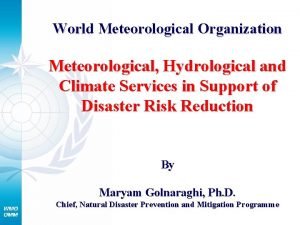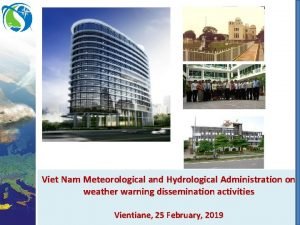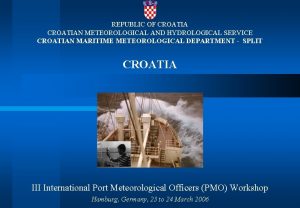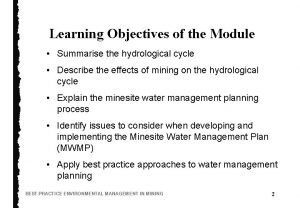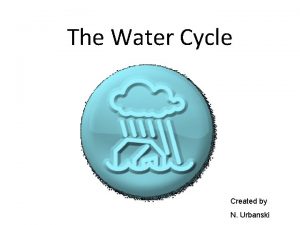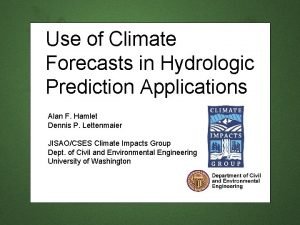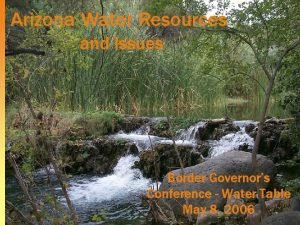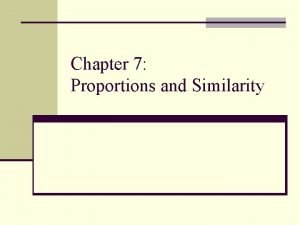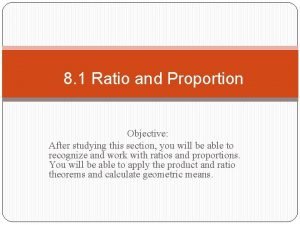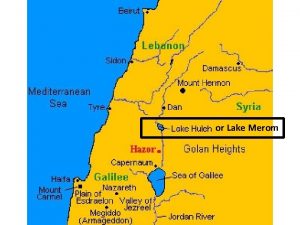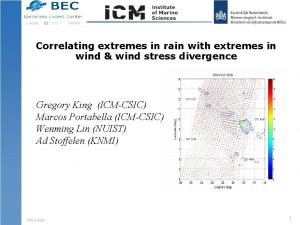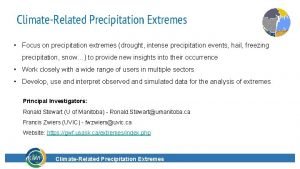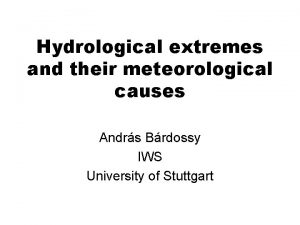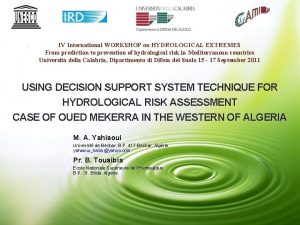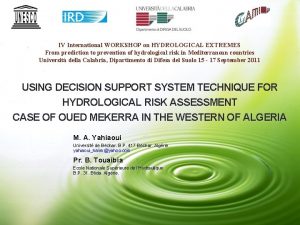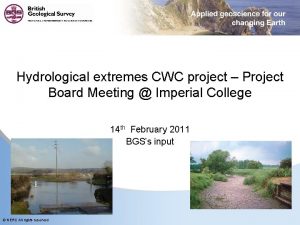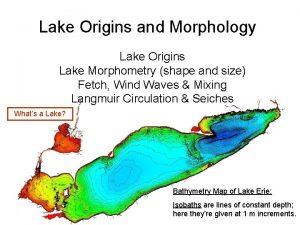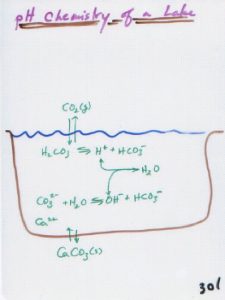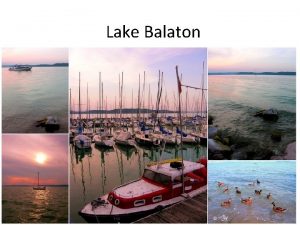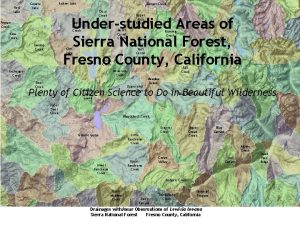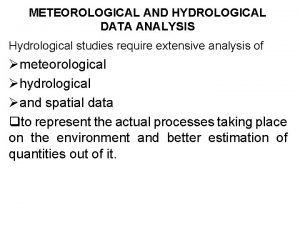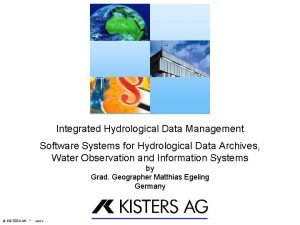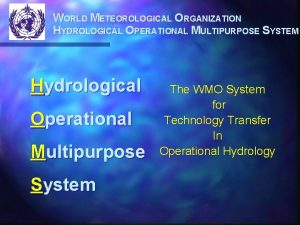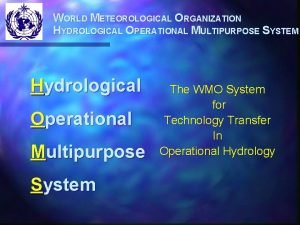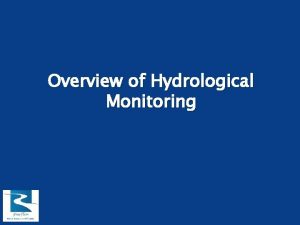Climate and Hydrological and Extremes in Lake Victoria





















- Slides: 21

Climate and Hydrological and Extremes in Lake Victoria Basin An Assessment of Vulnerability and Adaptation to Climate Variability and Change Impacts on Malaria and Health in the Lake Victoria Region in East Africa Dr. Daniel Olago Department of Geology University of Nairobi, Kenya

Lake Victoria Basin SITES Kenya: Kericho (malaria) and Kisumu (cholera). Tanzania: Bugarama village, Muleba District (malaria) and Chato Village, Biharamulo District (cholera). Uganda: Kasese, southwest Uganda (Malaria) and Gaba,

Objectives n 1. To analyse climate variability in temperature and rainfall extremes in relation to reported and documented malaria and cholera outbreaks in order to establish the coupling sensitivities and critical climate thresholds.

Data and Data Sources n n Climate data (rainfall and temperature) covering the period 1961 to the present has been collected from the various site-related meteorological stations in the Lake Victoria basin. Water resources data Long-term data (1961 -to the present) on river discharge has been obtained from Water Ministries and Meteorological Agencies.

Climate Data Preliminary Analysis: n n Meteorological data (temperature, rainfall, evaporation) has been obtained for all six sites from the Drought Monitoring Centre, Nairobi (DMCN) Below we outline the results obtained from Kenya, Uganda and Tanzania sites.

Climate Data Preliminary Analysis: The stations’ locations have been laid over the digital elevation model for the region (resolution: 1 km), the darker the brown shade, the higher the elevation. The elevations for the two main Meteorological stations are 1146 m for Kisumu and 2148 m for Kericho. n

Climate Data Preliminary Analysis: Comparison of mean monthly rainfall patterns in the study regions. n. On average, the study regions in Kisumu and Kericho receive about 1400 mm and 1940 mm of annual rainfall respectively. n. In Kericho, there about 7 months on average, within one year that receive more than 150 mm of rainfall as compared to only about 3 months in Kisumu. This should be compared to the fact that a minimum rainfall of 150 mm per month for 1 to 2 months is required to precipitate a malaria outbreak. n

Climate Data Preliminary Analysis: In Kisumu, the mean maximum temperature occurs in March and the mean minimum temperature occurs in July. The evaporation does not vary much and almost equals the rainfall, except during the rainy seasons where the rainfall is much more than the evaporation. In Kericho, the mean maximum temperature occurs in February and the mean minimum temperature occurs in September. Here the rainfall is seen to exceed the evaporation by large amounts even during the non-raining seasons, unlike for Kisumu. The pattern of humidity in both the study areas is a mirror image of evaporation. It ranges on average from 54% to 65% in Kisumu and 56% to 76% in Kericho.

Climate Data Preliminary Analysis: GCM Validation §The gridded data set was obtained from the Climatic Data Research Unit (CRU) website http: //www. cru. uea. ac. uk/cru/data/hrg. htm. §The baseline climatology is based on 1961 -1990 and is averaged in 0. 5 by 0. 5 degree grid boxes. §The baseline climatology extracted from the website is labelled CRU CL 1. 0. In addition, interpolated GCM experiments to be used for validation of projections are on the same website. §The experiments used in this exercise are labelled TYN SC 2. 0. The experiments contain time series of projected climate over the same grid boxes. § Actual rainfall data for the period 1961 -1990 was obtained from the Drought Monitoring Centre- Nairobi. §Nine stations around Lake Victoria were used in this exercise.

Climate Data Preliminary Analysis: GCM Validation §The gridded data sets were extracted using a program that was generated in-house. §The gridded rainfall data sets are archived in units of mm/day*10. The extracted data sets were converted to mm. §The extraction was done for 9 grid boxes each of which represented one station. § Mean monthly rainfall was computed for the 1961 -90 period for each of the stations using the actual time series of the station data. §Time series plots were drawn for each station in which the gridded monthly climatology was superimposed on the mean climatology from station data. § In addition, correlations and correlation coefficients were computed between the gridded climatology and the station climatology. §The correlation coefficients between the gridded data sets and the station climatology are all greater than 0. 9.

Climate Data Preliminary Analysis: GCM Validation – Time Series Plots for Tanzania The gridded data set compares very well with the station data for Bukoba There is a tendency for overestimating the station climatology at Musoma in J, F, N, D At Mwanza, the station climatology is overestimated during Jun, Aug, and underestimated in F, N, D

Climate Data Preliminary Analysis: GCM Validation – Time Series Plots for Kenya At Kakamega and Kisii, the gridded data set underestimates the station climatology for most of the months. This underestimation is more apparent at Kisii with deviations of about 50 mm during some months. At Kisumu, the gridded data set overestimates the station climatology during the relatively drier months of Jul to Sep and introduces a slight rainfall peak in August.

Climate Data Preliminary Analysis: GCM Validation – Time Series Plots for Uganda The gridded data set overestimates the station data during the long rains (March to May) season at Jinja and Kampala. It underestimates the station climatology for Entebbe during the same season. The differences during some months are close to 100 mm. At Entebbe, the peak rainfall month during the long rains season is depicted as April when the station climatology shows May as the peak.

Hydrology Data Preliminary Analysis: §Hydrological data has been obtained for Kenya sites (Sondu-Miriu and Awach River Basins). §Rivers in the Tanzania and Uganda sites are ungauaged. §Data gaps such as in river discharges were addressed with graphical or statistical (MOVE 1) methods of estimation. §Some water quality data is also available and their usefulness in relation to elucidating aspects of water related health risks is being assessed. §Some examples of the datasets are given below.

Hydrology Data Preliminary Analysis: §Preliminary results for the Kericho area, Kenya, show that highest discharge rates in Sondu_Miriu River occur in the six months from April to September. §Peak river discharge lags two of the three observed rainfall peaks (April and August) by one month, but is coincident with the rainfall peak in November.

Hydrology Data: Spectral Analysis: §The discharge data used in this case is in terms of months. § Two peaks predominate. A six months cycle (F=0. 1667) is seen for the first peak. §The second peak is centred at F=0. 0833 which is equivalent to a period of 12 months. §Hence seasonal and annual cycles are observed for the discharge over Sondu.

Hydrology Data: Spectral Analysis: § For the case of Awach, similar case like the one for Sondu is noticed where we have 6 month cycles(F=0. 1667) and annual cycles(F=0. 0833).

Hydrology Data: Analogues §the years 1962, 1963, 1964, 1968, 1970, 1977 and 1978 were associated with high flows/floods. §the periods 1965, 1969, 1972, 1976 and 1980 are associated with low flows/droughts.

Hydrology Data: Analogues §the periods 1966, 1968, 1977 and 1978 were basically wet periods associated with high flows/floods §the periods 1970, 1976, 1982, 1984, 1986 were associated with low flows/droughts

Hydrology Data: Flood Frequency Curve 1 JG 01_SONDU_RI VER Number of years : 45 Fitting procedure u = k = : GEV-PWM 143. 420 a = 96. 898 -. 4019 Return period Magn. S. E. 2. 181. 68 24. 19 5. 342. 88 48. 79 10. 497. 97 102. 78 25. 774. 27 267. 73 50. 1059. 15 500. 27 100. * 1433. 91 874. 69 200. * 1928. 00 1457. 19 §Standard error increases at high return periods – reliability of these models decrease at high return periods. §Return period for maximum discharge for 1961 -1981 is between 2 to 5 years.

Some Problems Encountered • GCM data: results from GCM simulations were to be used for validation of climate projections. Problem- downloading • GCMs – unsuitability for regional/local scale studies because of the course grid-size resolution. Need for downscaling. • Lack of high resolution data (DEM, landuse etc) • Scaling, for hydrology. The inputs have a much coarser resolution than the analysis size for the study area, for any meaningful results. • Lack of hydrological data for Tanzania and Uganda sites.
 Victoria privada
Victoria privada National meteorological and hydrological services
National meteorological and hydrological services Vietnam meteorological and hydrological administration
Vietnam meteorological and hydrological administration Croatian meteorological and hydrological service
Croatian meteorological and hydrological service Hydrological
Hydrological Condensation process example
Condensation process example Four parts of the water cycle
Four parts of the water cycle Hydrological prediction center
Hydrological prediction center Lake powell and lake mead
Lake powell and lake mead Lake powell and lake mead
Lake powell and lake mead Similarity ratio definition
Similarity ratio definition Chapter 7 similarity
Chapter 7 similarity Box and whisker plots worksheet
Box and whisker plots worksheet Ratio theorem
Ratio theorem Means and extremes
Means and extremes Means and extremes
Means and extremes Oligotrophic vs eutrophic
Oligotrophic vs eutrophic Climate change 2014 mitigation of climate change
Climate change 2014 mitigation of climate change Means-extremes property of proportion
Means-extremes property of proportion Bicultural couples tend to demonstrate extremes in
Bicultural couples tend to demonstrate extremes in Avoid extremes
Avoid extremes Equal ratio theorem
Equal ratio theorem

